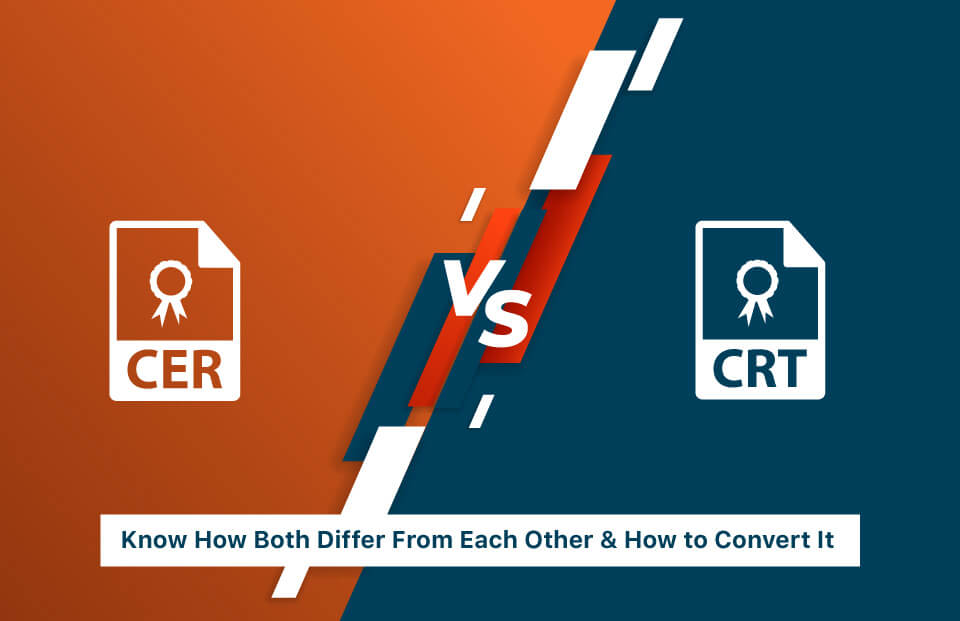CER vs CRT – Know How Both Differ From Each Other & How to Convert It

Here’s How Different File Formats of SSL Certificate Like CER & CRT Differs From Each Other
Having an SSL certificate installed isn’t something you can control. If you don’t have it installed, you’re going to face a warning message, and potentially your website may even fail to load on the browser. However, if you’re new to the SSL certificate, you may face some problems, such as how to install the SSL certificate or what documents to submit to get it issued.
One such issue faced by many is regarding the different file formats of the SSL certificate. Likewise, if you don’t have prior experience with SSL certificates, it’ll be more frustrating for you to find out what all these SSL certificate formats and extensions mean and what you should do with them.
Nonetheless, if you’ve come across any SSL file extensions such as CER or CRT, then don’t worry. We’ll explain it to you and let you know the difference between CER vs. CRT. Yes, we’ll provide you with information about how CER and CRT file extensions differ from each other. Instead of stressing about it, we’ll provide you with the solution. We’ll let you know how main file formats differ from each other.
CER vs. CRT – Here’s How Both Differs From Each Other
CER and CRT both file extensions are related to SSL certificates, and there’s not a significant difference between them, and they’re also quite similar for the SSL certificate. But, there’s a certain difference, which makes it quite substantial. For instance, some servers require CER file extensions while others go well with CRT file extensions.
These file extensions are used for an SSL certificate, and each of them is recorded within Binary DER or ASCII PEM file formats. Also, CER & CRT both file extensions are common among the Unix operating systems.
X.509 Certificate Have Different Filename Extensions
All SSL certificates are known as X.509 certificates. Similarly, these digital certificates also have different file extensions and formats. Some of the commonly used filename extensions that you should know about are:
- .p7c & .p7b – It’s just certificates or CRLs. A PKCS#7 SignedData structure without any data.
- .pfx – The predecessor of PKCS#12 PFX is the file extension that consists of PKCS#12 data. For instance, PFX files get generated in IIS.
- .p12 – It’s a PKCS#7 type of file format, which is password protected. Likewise, it may contain certificates that include private or public keys.
- .pem – PEM (Privacy Enhanced Electronic Mail) is the Base64-encoded DER certificate which is enclosed between the beginning and end line like: “—–BEGIN CERTIFICATE—–” and “—–END CERTIFICATE—–”.
.der, .crt & .cer – These certificates comes in two different file format Base64-encoded and Binary DER format. Likewise, it’s quite commonly used.
Different Servers Have Different File Extensions & Formats
Many servers are available in the market, and they accept certificate files that are formatted and encoded in a specific manner. For instance, if you’re looking to install an SSL certificate on your server, you should know your server accepts which file format and extension. Likewise, some server also accepts multiple file formats.
And, if you have received a particular file format from the CA like Sectigo or Comodo that doesn’t support your website server. In that case, you’ve got an option to convert into the different file formats supported by the server.
Here’s How to Convert CER to CRT
Though CRT and CER formats are quite similar, it’s possible to use both interchangeably by changing their extension. For instance, if your server accepts .CER file extension instead of .CRT extension then you can do so by simply converting it going through below mentioned steps:
- Double click and open the CRT file you received from the CA, such as yourdomainname.crt within the certificate display.
- Click on the tab named Details and select the button Copy to file.
- Click on the Next button and continue with the wizard.
- Click Next after selecting Base-64 encoded X.509 (.CER).
Browse and store your file and type within the filename you’re looking to keep. Lastly, save the file.
